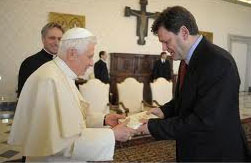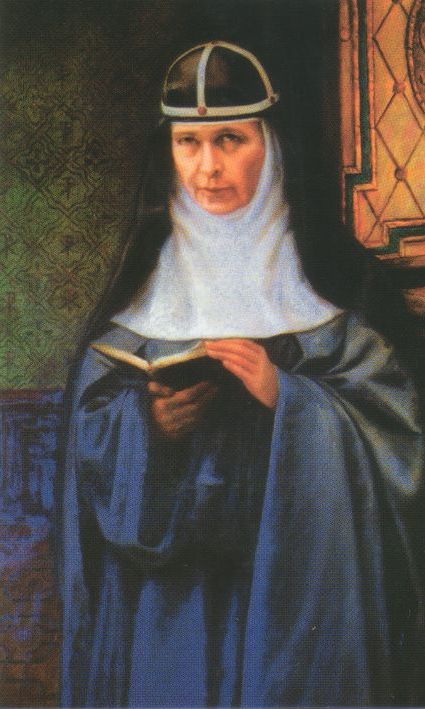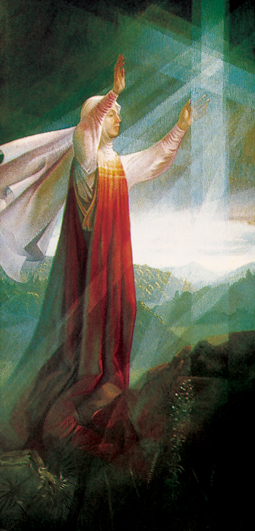An unprecedented book-length interview given by a Pope, Light of the World by German journalist Peter Seewald, is an absolute must for those who look to our Holy Father for guidance and direction as we  attempt to deepen our relationship with Jesus Christ. I am beyond delighted to have Amy Welborn with us to discuss this important conversation Pope Benedict XVI is actually having with us all. Amy, the author of numerous books, has written extensively on the teachings of Pope Benedict; I couldn’t have anyone better to go “Inside the Pages” of this work that tackles some the greatest issues facing the world today.
attempt to deepen our relationship with Jesus Christ. I am beyond delighted to have Amy Welborn with us to discuss this important conversation Pope Benedict XVI is actually having with us all. Amy, the author of numerous books, has written extensively on the teachings of Pope Benedict; I couldn’t have anyone better to go “Inside the Pages” of this work that tackles some the greatest issues facing the world today.
[powerpress]
Check out Amy Welborn’s blog “Charlotte was Both“
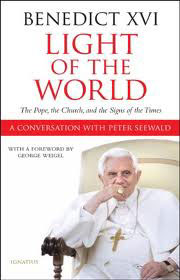 You can find our more at igantius.com the website for Ignatius Press
You can find our more at igantius.com the website for Ignatius Press
Tags: amy welborn, catholic, catholic podcast, catholic prayer, cathollc spirituality, ignatius press, peter seewald, pope benedict, pope benedict xvi
This entry was posted on Tuesday, December 7th, 2010 at 7:28 am
You can follow any responses to this entry through the RSS 2.0 feed.
Be sure to visit the St. Bridget Discerning Hearts page!!!
And here is an earlier Discerning Hearts post on St. Bridget!
Vatican City, Oct 27, 2010 Pope Benedict’s General Audience from vatican.va
Saint Bridget of Sweden
Dear Brothers and Sisters,
On the eve of the Great Jubilee in anticipation of the Year 2000 the Venerable Servant of God John Paul II proclaimed St Bridget of Sweden Co-Patroness of the whole of Europe. This morning I would like to present her, her message and the reasons why — still today — this holy woman has much to teach the Church and the world.
We are well acquainted with the events of St Bridget’s life because her spiritual fathers compiled her biography in order to further the process of her canonization immediately after her death in 1373. Bridget was born 70 years earlier, in 1303, in Finster, Sweden, a Northern European nation that for three centuries had welcomed the Christian faith with the same enthusiasm as that with which the Saint had received it from her parents, very devout people who belonged to noble families closely related to the reigning house.
We can distinguished two periods in this Saint’s life.
The first was characterized by her happily married state. Her husband was called Ulf and he was Governor of an important district of the Kingdom of Sweden. The marriage lasted for 28 years, until Ulf’s death. Eight children were born, the second of whom, Karin (Catherine), is venerated as a Saint. This is an eloquent sign of Bridget’s dedication to her children’s education. Moreover, King Magnus of Sweden so appreciated her pedagogical wisdom that he summoned her to Court for a time, so that she could introduce his young wife, Blanche of Namur, to Swedish culture. Bridget, who was given spiritual guidance by a learned religious who initiated her into the study of the Scriptures, exercised a very positive influence on her family which, thanks to her presence, became a true “domestic churchâ€. Together with her husband she adopted the Rule of the Franciscan Tertiaries. She generously practiced works of charity for the poor; she also founded a hospital. At his wife’s side Ulf’s character improved and he advanced in the Christian life. On their return from a long pilgrimage to Santiago de Compostela, which they made in 1341 with other members of the family, the couple developed a project of living in continence; but a little while later, in the tranquillity of a monastery to which he had retired, Ulf’s earthly life ended. This first period of Bridget’s life helps us to appreciate what today we could describe as an authentic “conjugal spiritualityâ€: together, Christian spouses can make a journey of holiness sustained by the grace of the sacrament of Marriage. It is often the woman, as happened in the life of St Bridget and Ulf, who with her religious sensitivity, delicacy and gentleness succeeds in persuading her husband to follow a path of faith. I am thinking with gratitude of the many women who, day after day, illuminate their families with their witness of Christian life, in our time too. May the Lord’s Spirit still inspire holiness in Christian spouses today, to show the world the beauty of marriage lived in accordance with the Gospel values: love, tenderness, reciprocal help, fruitfulness in begetting and in raising children, openness and solidarity to the world and participation in the life of the Church.
The second period of Bridget’s life began when she was widowed. She did not consider another marriage in order to deepen her union with the Lord through prayer, penance and charitable works. Therefore Christian widows too may find in this Saint a model to follow. In fact, upon the death of her husband, after distributing her possessions to the poor — although she never became a consecrated religious — Bridget settled near the Cistercian Monastery of Alvastra. Here began the divine revelations that were to accompany her for the rest of her life. Bridget dictated them to her confessors-secretaries, who translated them from Swedish into Latin and gathered them in eight volumes entitled Revelationes (Revelations). A supplement followed these books called, precisely,Revelationes extravagantes (Supplementary revelations).
St Bridget’s Revelations have a very varied content and style. At times the revelations are presented in the form of dialogues between the divine Persons, the Virgin, the Saints and even demons; they are dialogues in which Bridget also takes part. At other times, instead, a specific vision is described; and in yet others what the Virgin Mary reveals to her concerning the life and mysteries of the Son.
The value of St Bridget’s Revelations, sometimes the object of criticism Venerable John Paul II explained in his Letter Spes Aedificandi: “The Church, which recognized Bridget’s holiness without ever pronouncing on her individual revelations, has accepted the overall authenticity of her interior experience†(n. 5). Indeed, reading these Revelations challenges us on many important topics. For example, the description of Christ’s Passion, with very realistic details, frequently recurs. Bridget always had a special devotion to Christ’s Passion, contemplating in it God’s infinite love for human beings. She boldly places these words on the lips of the Lord who speaks to her: “O my friends, I love my sheep so tenderly that were it possible I would die many other times for each one of them that same death I suffered for the redemption of all†(Revelationes, Book I, c. 59). The sorrowful motherhood of Mary, which made her Mediatrix and Mother of Mercy, is also a subject that recurs frequently in the Revelations.
In receiving these charisms, Bridget was aware that she had been given a gift of special love on the Lord’s part: “My Daughter†— we read in the First Book of Revelations — “I have chosen you for myself, love me with all your heart… more than all that exists in the world†(c. 1). Bridget, moreover, knew well and was firmly convinced that every charism is destined to build up the Church. For this very reason many of her revelations were addressed in the form of admonishments, even severe ones, to the believers of her time, including the Religious and Political Authorities, that they might live a consistent Christian life; but she always reprimanded them with an attitude of respect and of full fidelity to the Magisterium of the Church and in particular to the Successor of the Apostle Peter.
In 1349 Bridget left Sweden for good and went on pilgrimage to Rome. She was not only intending to take part in the Jubilee of the Year 1350 but also wished to obtain from the Pope approval for the Rule of a Religious Order that she was intending to found, called after the Holy Saviour and made up of monks and nuns under the authority of the Abbess. This is an element we should not find surprising: in the Middle Ages monastic foundations existed with both male and female branches, but with the practice of the same monastic Rule that provided for the Abbess’ direction. In fact, in the great Christian tradition the woman is accorded special dignity and — always based on the example of Mary, Queen of Apostles — a place of her own in the Church, which, without coinciding with the ordained priesthood is equally important for the spiritual growth of the Community. Furthermore, the collaboration of consecrated men and women, always with respect for their specific vocation, is of great importance in the contemporary world. In Rome, in the company of her daughter Karin, Bridget dedicated herself to a life of intense apostolate and prayer. And from Rome she went on pilgrimage to various Italian Shrines, in particular to Assisi, the homeland of St Francis for whom Bridget had always had great devotion. Finally, in 1371, her deepest desire was crowned: to travel to the Holy Land, to which she went accompanied by her spiritual children, a group that Bridget called “the friends of Godâ€. In those years the Pontiffs lived at Avignon, a long way from Rome: Bridget addressed a heartfelt plea to them to return to the See of Peter, in the Eternal City. She died in 1373, before Pope Gregory XI returned to Rome definitively. She was buried temporarily in the Church of San Lorenzo in Panisperna in Rome but in 1374 her children, Birger and Karin, took her body back to her homeland, to the Monastery of Vadstena, the headquarters of the Religious Order St Bridget had founded. The order immediately experienced a considerable expansion. In 1391 Pope Boniface IX solemnly canonized her. Bridget’s holiness, characterized by the multiplicity of her gifts and the experiences that I have wished to recall in this brief biographical and spiritual outline, makes her an eminent figure in European history. In coming from Scandinavia, St Bridget bears witness to the way Christianity had deeply permeated the life of all the peoples of this Continent. In declaring her Co-Patroness of Europe, Pope John Paul II hoped that St Bridget — who lived in the 14th century when Western Christianity had not yet been wounded by division — may intercede effectively with God to obtain the grace of full Christian unity so deeply longed for.
Let us pray, dear brothers and sisters, for this same intention, which we have very much at heart, and that Europe may always be nourished by its Christian roots, invoking the powerful intercession of St Bridget of Sweden, a faithful disciple of God and Co-Patroness of Europe. Thank you for your attention.
Tags: Bridget Discerning Hearts, catholic, catholic podcast, catholic prayer, cathollc spirituality, devotion, holy women, love, motherhood, mystic, mystic of the Church, mystical expeeriences, mystical experiences, mystical revelations, pope benedict xvi, st bridget of sweden, St. Bridget, Sweden, women of the middle ages
This entry was posted on Wednesday, October 27th, 2010 at 6:07 pm
You can follow any responses to this entry through the RSS 2.0 feed.
Thank God for our Holy Father, Pope Benedict XVI, and his desire to teach us about the heritage contained in our faith. I love it now, because once again he is lifting up one of the truly gifted women mystics of the Church for all of us to learn from. I didn’t know much about her, until his teaching, but now…wow! What a story…I can’t wait to get to know her better! Blessed Angela, pray for us!
From the Pope Benedict’s Wednesday audience from vatican.va
Dear Brothers and Sisters,
Today I would like to speak to you about Blessed Angela of Foligno, a great medieval mystic who lived in the 13th century. People are usually fascinated by the consummate experience of union with God that she reached, but perhaps they give too little consideration to her first steps, her conversion and the long journey that led from her starting point, the “great fear of hell”, to her goal, total union with the Trinity. The first part of Angela’s life was certainly not that of a fervent disciple of the Lord. She was born into a well-off family in about 1248. Her father died and she was brought up in a somewhat superficial manner by her mother. She was introduced at a rather young age into the worldly circles of the town of Foligno, where she met a man whom she married at the age of 20 and to whom she bore children. Her life was so carefree that she was even contemptuous of the so-called “penitents”, who abounded in that period; they were people who, in order to follow Christ, sold their possessions and lived in prayer, fasting, in service to the Church and in charity.
Certain events, such as the violent earthquake in 1279, a hurricane, the endless war against Perugia and its harsh consequences, affected the life of Angela who little by little became aware of her sins, until she took a decisive step. In 1285 she called upon St Francis, who appeared to her in a vision and asked his advice on making a good general Confession. She then went to Confession with a Friar in San Feliciano. Three years later, on her path of conversion she reached another turning point: she was released from any emotional ties. In the space of a few months, her mother’s death was followed by the death of her husband and those of all her children. She therefore sold her possessions and in 1291 enrolled in the Third Order of St Francis. She died in Foligno on 4 January 1309.
The Book of Visions and Instructions of Blessed Angela of Foligno, in which is gathered the documentation on our Blessed, tells the story of this conversion and points out the necessary means: penance, humility and tribulation; and it recounts the steps, Angela’s successive experiences which began in 1285. Remembering them after she had experienced them, Angela then endeavoured to recount them through her Friar confessor, who faithfully transcribed them, seeking later to sort them into stages which he called “steps or mutations” but without managing to put them entirely in order (cf. Il Libro della beata Angela da Foligno, Cinisello Balsamo 1990, p. 51). This was because for Blessed Angela the experience of union meant the total involvement of both the spiritual and physical senses and she was left with only a “shadow” in her mind, as it were, of what she had “understood” during her ecstasies. “I truly heard these words”, she confessed after a mystical ecstasy, but it is in no way possible for me to know or tell of what I saw and understood, or of what he [God] showed me, although I would willingly reveal what I understood with the words that I heard, but it was an absolutely ineffable abyss”. Angela of Foligno presented her mystical “life”, without elaborating on it herself because these were divine illuminations that were communicated suddenly and unexpectedly to her soul. Her Friar confessor too had difficulty in reporting these events, “partly because of her great and wonderful reserve concerning the divine gifts” (ibid., p. 194). In addition to Angela’s difficulty in expressing her mystical experience was the difficulty her listeners found in understanding her. It was a situation which showed clearly that the one true Teacher, Jesus, dwells in the heart of every believer and wants to take total possession of it. So it was with Angela, who wrote to a spiritual son: “My son, if you were to see my heart you would be absolutely obliged to do everything God wants, because my heart is God’s heart and God’s heart is mine”. Here St Paul’s words ring out: “It is no longer I who live, but Christ who lives in me” (Gal 2: 20).
Let us then consider only a few “steps” of our Blessed’s rich spiritual journey. The first, in
fact, is an introduction: “It was the knowledge of sin”, as she explained, “after which my soul was deeply afraid of damnation; in this stage I shed bitter tears” (Il Libro della beata Angela da Foligno, p. 39). This “dread” of hell corresponds to the type of faith that Angela had at the time of her “conversion”; it was a faith still poor in charity, that is, in love of God. Repentance, the fear of hell and penance unfolded to Angela the prospect of the sorrowful “Way of the Cross”, which from the eighth to the 15th stages was to lead her to the “way of love”. Her Friar confessor recounted: “The faithful woman then told me: I have had this divine revelation: “after the things you have written, write that anyone who wishes to preserve grace must not lift the eyes of his soul from the Cross, either in the joy or in the sadness that I grant or permit him'” (ibid., p. 143). However, in this phase Angela “did not yet feel love”. She said: “The soul feels shame and bitterness and does not yet feel love but suffering” (ibid., p. 39), and is unrequited.
Angela felt she should give something to God in reparation for her sins, but slowly came to realize that she had nothing to give him, indeed, that she “was nothing” before him. She understood that it would not be her will to give her God’s love, for her will could give only her own “nothingness”, her “non-love”. As she was to say: only “true and pure love, that comes from God, is in the soul and ensures that one recognizes one’s own shortcomings and the divine goodness…. Such love brings the soul to Christ and it understands with certainty that in him no deception can be found or can exist. No particle of worldly love can be mingled with this love” (ibid., p. 124-125). This meant opening herself solely and totally to God’s love whose greatest expression is in Christ: “O my God” she prayed, “make me worthy of knowing the loftiest mystery that your most ardent and ineffable love brought about for our sake, together with the love of the Trinity, in other words the loftiest mystery of your most holy Incarnation…. O incomprehensible love! There is no greater love than this love that brought my God to become man in order to make me God” (ibid., p. 295). However, Angela’s heart always bore the wounds of sin; even after a good Confession she would find herself forgiven and yet still stricken by sin, free and yet conditioned by the past, absolved but in need of penance. And the thought of hell accompanied her too, for the greater the progress the soul made on the way of Christian perfection, the more convinced it is not only of being “unworthy” but also deserving of hell.
And so it was that on this mystical journey Angela understood the central reality in a profound way: what would save her from her “unworthiness” and from “deserving hell” would not be her “union with God” or her possession of the “truth” but Jesus Crucified, “his crucifixion for me”, his love.
In the eighth step, she said, “However, I did not yet understand whether my liberation from sins and from hell and conversion to penance was far greater, or his crucifixion for me” (ibid., n. 41). This was the precarious balance between love and suffering, that she felt throughout her arduous journey towards perfection. For this very reason she preferred to contemplate Christ Crucified, because in this vision she saw the perfect balance brought about. On the Cross was the man-God, in a supreme act of suffering which was a supreme act of love. In the third Instruction the Blessed insisted on this contemplation and declared: “The more perfectly and purely we see, the more perfectly and purely we love…. Therefore the more we see the God and man, Jesus Christ, the more we are transformed in him through love…. What I said of love… I also say of suffering: the more the soul contemplates the ineffable suffering of the God and man Jesus Christ the more sorrowful it becomes and is transformed through suffering” (ibid., p. 190-191). Thus, unifying herself with and transforming herself into the love and suffering of Christ Crucified, she was identifying herself with him. Angela’s conversion, which began from that Confession in 1285, was to reach maturity only when God’s forgiveness appeared to her soul as the freely given gift of the love of the Father, the source of love: “No one can make excuses”, she said, “because anyone can love God and he does not ask the soul for more than to love him, because he loves the soul and it is his love” (ibid., p. 76).On Angela’s spiritual journey the transition from conversion to mystical experience, from what can be expressed to the inexpressible, took place through the Crucified One. He is the “God-man of the Passion”, who became her “teacher of perfection”. The whole of her mystical experience, therefore, consisted in striving for a perfect “likeness” with him, through ever deeper and ever more radical purifications and transformations. Angela threw her whole self, body and soul, into this stupendous undertaking, never sparing h
erself of penance and suffering, from beginning to end, desiring to die with all the sorrows suffered by the God-man crucified in order to be totally transformed in him. “O children of God”, she recommended, “transform yourselves totally in the man-God who so loved you that he chose to die for you a most ignominious and all together unutterably painful death, and in the most painful and bitterest way. And this was solely for love of you, O man!” (ibid., p. 247). This identification also meant experiencing what Jesus himself experienced: poverty, contempt and sorrow, because, as she declared, “through temporal poverty the soul will find eternal riches; through contempt and shame it will obtain supreme honour and very great glory; through a little penance, made with pain and sorrow, it will possess with infinite sweetness and consolation the Supreme Good, Eternal God” (ibid., p. 293).
From conversion to mystic union with Christ Crucified, to the inexpressible. A very lofty journey, whose secret is constant prayer. “The more you pray”, she said, “the more illumined you will be and the more profoundly and intensely you will see the supreme Good, the supremely good Being; the more profoundly and intensely you see him, the more you will love him; the more you love him the more he will delight you; and the more he delights you, the better you will understand him and you will become capable of understanding him. You will then reach the fullness of light, for you will understand that you cannot understand” (ibid., p. 184).
Dear brothers and sisters, Blessed Angela’s life began with a worldly existence, rather remote from God. Yet her meeting with the figure of St Francis and, finally, her meeting with Christ Crucified reawakened her soul to the presence of God, for the reason that with God alone life becomes true life, because, in sorrow for sin, it becomes love and joy. And this is how Blessed Angela speaks to us. Today we all risk living as though God did not exist; he seems so distant from daily life. However, God has thousands of ways of his own for each one, to make himself present in the soul, to show that he exists and knows and loves me. And Blessed Angela wishes to make us attentive to these signs with which the Lord touches our soul, attentive to God’s presence, so as to learn the way with God and towards God, in communion with Christ Crucified. Let us pray the Lord that he make us attentive to the signs of his presence and that he teach us truly to live. Thank you.
Tags: Blessed Angela, catholic, catholic podcast, catholic prayer, catholic saints, cathollc spirituality, holy father, mystic, mystics of the church, pope benedict xvi, prayer, women of the middle ages
This entry was posted on Thursday, October 14th, 2010 at 1:46 pm
You can follow any responses to this entry through the RSS 2.0 feed.
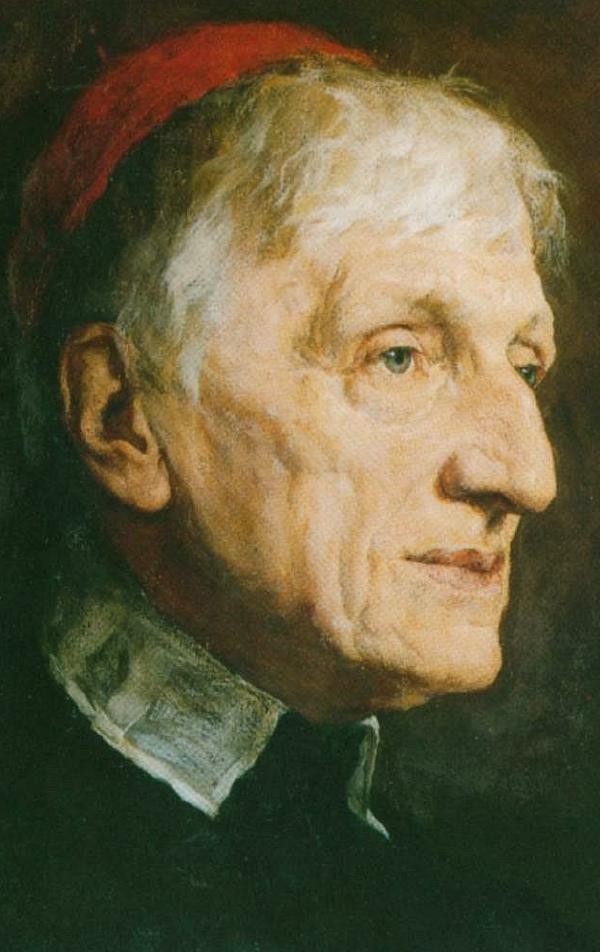 “Much loved father of souls…” Pope Benedict XVI
“Much loved father of souls…” Pope Benedict XVI
As reported by the Catholic Herald UK
Pope Benedict XVI today beatified Cardinal John Henry Newman in a historic Mass at Cofton Park, Birmingham – the first beatification ever to take place on British soil.
In his homily, the Pope placed Cardinal Newman in a tradition of English martyrs and saintly scholars, and praised the “warmth and humanity†of his priestly ministry.
He also noted that it was the 70th anniversary of the Battle of Britain, and paid tribute to English men and women who resisted the “evil ideology†of Nazism.
He said: “For me as one who lived and suffered through the dark days of the Nazi regime in Germany, it is deeply moving to be here with you on this occasion, and to recall how many of your fellow citizens sacrificed their lives, courageously resisting the forces of that evil ideology.
“My thoughts go in particular to nearby Coventry, which suffered such heavy bombardment and massive loss of life in November 1940,†the Pope said.
He explained Newman was the latest in a “long line†of saintly British scholars, including St Bede, St Hilda, St Aelred, and Blessed Duns Scotus. It was a tradition, he said, “of gentle scholarship, deep human wisdom and profound love for the Lordâ€.
He pointed to Newman’s “devoted care for the people of Birmingham … visiting the sick and the poor, comforting the bereaved, caring for those in prisonâ€.
“No wonder,†he said, “that on his death so many thousands of people lined the local streets as his body was taken to its place of burial not half a mile from hereâ€.
The Pope said that given his holiness it was fitting he should take his place beside England’s martyrs, “whose courageous witness has sustained and inspired the Catholic community here for centuriesâ€.
Pope Benedict said his vision of education had “done so much to shape the ethos that is the driving force behind Catholic schools and colleges todayâ€.
He quoted Cardinal Newman’s appeal for a well-instructed laity as a goal for all teachers of religion. He said: “ ‘I want a laity not arrogant, not rash in speech, not disputatious, but men who know their religion, who enter into it, who know just where they stand, who know what they hold and what they do not, who know their creed so well that they can give an account of it, who know so much of history that they can defend it.’ â€
The Pope added: “I pray that, through his intercession and example, all who are engaged in the task of teaching and catechesis will be inspired to greater effort by the vision he so clearly sets before us.â€
He also spoke about Newman’s holiness, saying it was a “profound desire of the human heart to enter into intimate communion with the Heart of Godâ€.
The Pope spoke in front of tens of thousands of pilgrims, some of whom had slept overnight at Cofton Park in sleeping bags. Others had set off from parishes as early as 2am in special pilgrim buses. Fr Tim Finigan, parish priest at Blackfen, Kent, tweeted: “Apologies to the neighbours for waking them up last night singing ‘God bless our Pope’ as the coach left for Birmingham. Won’t happen again.â€
According to Simon Caldwell, the Catholic Herald’s news editor, rain poured down all morning until just before the Pope’s helicopter landed nearby, when the sun finally came out.
Deacon Jack Sullivan, who was healed of a severe spinal disorder after praying for Newman’s intercession, proclaimed the Gospel during the Mass. It was his inexplicable healing that led to Newman being made a Blessed.
A choir of 1,200 sung a new setting of the Mass by composer James MacMillan. The prayers of the faithful were made in German, Welsh, French, Vietnamese and Punjabi.” – Catholic Herald UK
Tags: catholic, catholic podcast, catholic prayer, cathollc spirituality, john henry newman, pope benedict xvi
This entry was posted on Sunday, September 19th, 2010 at 9:32 pm
You can follow any responses to this entry through the RSS 2.0 feed.
Pope Benedict XVI and the Sexual Abuse Scandal is an important contribution to the understanding and healin g of the great heartache that has inflicted the Church over the last 30 years. Talking with Gregory Erlandson was a great opportunity to realize the nuisances of what got us here, but also the response and hope that leads us to the future.
g of the great heartache that has inflicted the Church over the last 30 years. Talking with Gregory Erlandson was a great opportunity to realize the nuisances of what got us here, but also the response and hope that leads us to the future.
The wonderful David Scott, put it best:
This is Catholic journalism at its best. Erlandson and Bunson are two of most knowledgeable people in the world on the Church and this book shows it. Good reporting, sharply written, smart analysis, not afraid of the hard questions–even if the answers don’t always put the Church in the best light. This book should be in every mainstream newsroom in the country. It offers a definitive historical overview of the abuse scandal and Pope Benedict’s role, first as head of the Vatican’s doctrine office and now as Pope. This should be an eye-opener for those who think Benedict has been negligent or worse. The facts just don’t support the conclusions that the mainstream media has been insisting upon. In addition to good reporting, this book provides excellent documentation–full texts of every reference Benedict has made on the crisis, including his addresses to the 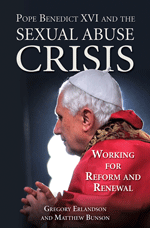 U.S. bishops and his historic letter to the people of Ireland. A good read and an essential reference.
U.S. bishops and his historic letter to the people of Ireland. A good read and an essential reference.
Find more this book at www.osv.com
[powerpress]
Tags: catholic, catholic podcast, catholic prayer, cathollc spirituality, pope benedict, pope benedict xvi, Sexual Abuse Scandal
This entry was posted on Thursday, September 9th, 2010 at 11:09 pm
You can follow any responses to this entry through the RSS 2.0 feed.
Part 2 of the discussion with Gregory Erlandson. Pope Benedict XVI and the Sexual Abuse Scandal is an important contribution to the understanding and healing of the great heartache that has inflicted the Church over the last 30 years. Talking with Gregory Erlandson was a great opportunity to realize the nuisances of what got us here, but also the response and hope that leads us to the future.
[powerpress]
Tags: catholic, catholic podcast, catholic prayer, cathollc spirituality, Church, Gregory Erlandson, hope, osv, our sunday visitor, pope benedict xvi, Sexual Abuse Scandal
This entry was posted on Thursday, September 9th, 2010 at 11:08 pm
You can follow any responses to this entry through the RSS 2.0 feed.
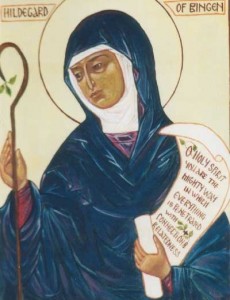 Once again the Holy Father, Pope Benedict XVI speaks of the importance of St. Hildegard of Bingen.
Once again the Holy Father, Pope Benedict XVI speaks of the importance of St. Hildegard of Bingen.
Vatican City – Pope Benedict’s General Audience from Vatican.va
Dear Brothers and Sisters, Today I would like to take up and continue my Reflection on St Hildegard of Bingen, an important female figure of the Middle Ages who was distinguished for her spiritual wisdom and the holiness of her life. Hildegard’s mystical visions resemble those of the Old Testament prophets: expressing herself in the cultural and religious categories of her time, she interpreted the Sacred Scriptures in the light of God, applying them to the various circumstances of life. Thus all those who heard her felt the need to live a consistent and committed Christian lifestyle. In a letter to St Bernard the mystic from the Rhineland confesses: “The vision fascinates my whole being: I do not see with the eyes of the body but it appears to me in the spirit of the mysteries…. I recognize the deep meaning of what is expounded on in the Psalter, in the Gospels and in other books, which have been shown to me in the vision. This vision burns like a flame in my breast and in my soul and teaches me to understand the text profoundly” (Epistolarium pars prima I-XC: CCCM 91). Hildegard’s mystical visions have a rich theological content. They refer to the principal events of salvation history, and use a language for the most part poetic and symbolic. For example, in her best known work entitled Scivias, that is, “You know the ways” she sums up in 35 visions the events of the history of salvation from the creation of the world to the end of time. With the characteristic traits of feminine sensitivity, Hildegard develops at the very heart of her work the theme of the mysterious marriage between God and humanity that is brought about in the Incarnation. On the tree of the Cross take place the nuptials of the Son of God with the Church, his Bride, filled with grace and the ability to give new children to God, in the love of the Holy Spirit (cf. Visio tertia: PL 197, 453c).
From these brief references we already see that theology too can receive a special contribution from women because they are able to talk about God and the mysteries of faith using their own particular intelligence and sensitivity. I therefore encourage all those who carry out this service to do it with a profound ecclesial spirit, nourishing their own reflection with prayer and looking to the great riches, not yet fully explored, of the medieval mystic tradition, especially that represented by luminous models such as Hildegard of Bingen.
The Rhenish mystic is also the author of other writings, two of which are particularly important since, like Scivias, they record her mystical visions: they are the Liber vitae meritorum (Book of the merits of life) and the Liber divinorum operum (Book of the divine works), also called De operatione Dei. In the former she describes a unique and powerful vision of God who gives life to the cosmos with his power and his light. Hildegard stresses the deep relationship that exists between man and God and reminds us that the whole creation, of which man is the summit, receives life from the Trinity. The work is centred on the relationship between virtue and vice, which is why human beings must face the daily challenge of vice that distances them on their way towards God and of virtue that benefits them. The invitation is to distance themselves from evil in order to glorify God and, after a virtuous existence, enter the life that consists “wholly of joy”. In her second work that many consider her masterpiece she once again describes creation in its relationship with God and the centrality of the human being, expressing a strong Christo-centrism with a biblical-Patristic flavour. The Saint, who presents five visions inspired by the Prologue of the Gospel according to St John, cites the words of the Son to the Father: “The whole task that you wanted and entrusted to me I have carried out successfully, and so here I am in you and you in me and we are one” (Pars III, Visio X: PL 197, 1025a). Finally, in other writings Hildegard manifests the versatility of interests and cultural vivacity of the female monasteries of the Middle Ages, in a manner contrary to the prejudices which still weighed on that period. Hildegard took an interest in medicine and in the natural sciences as well as in music, since she was endowed with artistic talent. Thus she composed hymns, antiphons and songs, gathered under the title: Symphonia Harmoniae Caelestium Revelationum (Symphony of the Harmony of Heavenly Revelations), that were performed joyously in her monasteries, spreading an atmosphere of tranquillity and that have also come down to us. For her, the entire creation is a symphony of the Holy Spirit who is in himself joy and jubilation.
The popularity that surrounded Hildegard impelled many people to seek her advice. It is for this reason that we have so many of her letters at our disposal. Many male and female monastic communities turned to her, as well as Bishops and Abbots. And many of her answers still apply for us. For instance, Hildegard wrote these words to a community of women religious: “The spiritual life must be tended with great dedication. At first the effort is burdensome because it demands the renunciation of caprices of the pleasures of the flesh and of other such things. But if she lets herself be enthralled by holiness a holy soul will find even contempt for the world sweet and lovable. All that is needed is to take care that the soul does not shrivel” (E. Gronau, Hildegard. Vita di una donna profetica alle origini dell’età moderna, Milan 1996, p. 402). And when the Emperor Frederic Barbarossa caused a schism in the Church by supporting at least three anti-popes against Alexander iii, the legitimate Pope, Hildegard did not hesitate, inspired by her visions, to remind him that even he, the Emperor, was subject to God’s judgement. With fearlessness, a feature of every prophet, she wrote to the Emperor these words as spoken by God: “You will be sorry for this wicked conduct of the godless who despise me! Listen, O King, if you wish to live! Otherwise my sword will pierce you!” (ibid., p. 412). With the spiritual authority with which she was endowed, in the last years of her life Hildegard set out on journeys, despite her advanced age and the uncomfortable conditions of travel, in order to speak to the people of God. They all listened willingly, even when she spoke severely: they considered her a messenger sent by God. She called above all the monastic communities and the clergy to a life in conformity with their vocation. In a special way Hildegard countered the movement of German cátari (Cathars). They cátari means literally “pure” advocated a radical reform of the Church, especially to combat the abuses of the clergy.
She harshly reprimanded them for seeking to subvert the very nature of the Church, reminding them that a true renewal of the ecclesial community is obtained with a sincere spirit of repentance and a demanding process of conversion, rather than with a change of structures. This is a message that we should never forget. Let us always invoke the Holy Spirit, so that he may inspire in the Church holy and courageous women, like St Hildegard of Bingen, who, developing the gifts they have received from God, make their own special and valuable contribution to the spiritual development of our communities and of the Church in our time.
Tags: catholic, catholic podcast, catholic prayer, cathollc spirituality, Church, courageous women, Hildegard of Bingen, holy spirit, mysteries, mystic of the Church, mystics, pope benedict, pope benedict xvi, st hildegard of bingen, women, women of the middle ages
This entry was posted on Wednesday, September 8th, 2010 at 4:08 pm
You can follow any responses to this entry through the RSS 2.0 feed.
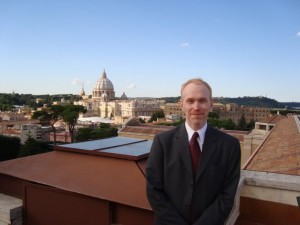 Here is part 2 of the discussion with Dr. Matthew Bunson, with the emphasis on the renewal and reform that has occured in the Church since the outbreak of the sexual abuse scandal. Dr. Bunson is once again EXCELLENT in articulating the problems which have surfaced, but also the response of the Church from its heart to the issue. It would be hard to find someone who does it better.
Here is part 2 of the discussion with Dr. Matthew Bunson, with the emphasis on the renewal and reform that has occured in the Church since the outbreak of the sexual abuse scandal. Dr. Bunson is once again EXCELLENT in articulating the problems which have surfaced, but also the response of the Church from its heart to the issue. It would be hard to find someone who does it better.
Dr. Bunson’s book can found at:
osv.com
[powerpress]
Tags: catholic, catholic podcast, catholic prayer, cathollc spirituality, inside the pages, matthew bunson, our sunday visitor, pope benedict xvi, sexual abuse, Sexual Abuse Scandal
This entry was posted on Thursday, July 15th, 2010 at 10:13 am
You can follow any responses to this entry through the RSS 2.0 feed.
For 100+ reasons, I love Dr. Matthew Bunson. No one I know has quite the depth of knowledge that he has and the ability to calmly disseminate it! His new book, co-authored with Gregory Erlandson, is OUTSTANDING! Please don’t say you have  formed your final opinion on this tragic period in Church history without reading “Pope Benedict XVI and the Sexual Abuse Crisis: Working for Reform and Renewal”. Don’t count on the secular media (and inparticular the NYT) to educate yourself on this matter. No one has done a better job chronicling this crisis and our Holy Father’s true response to this matter, then these two writers. The resources and prayers in the back of the book are excellent! Thank you Matthew and Gregory.
[powerpress]
Dr. Bunson’s book can found at:
osv.com
Dr. Bunson has been a frequent quest on Spirit Mornings with Bruce and Kris McGregor…check him out on the archives page! (I have got to him his own page soon…long, long overdue!!!!)
![]()
Tags: catholic, catholic podcast, catholic prayer, cathollc spirituality, erlandson, Gregory Erlandson, inside the pages, matthew bunson, mcgregor, our sunday visitor, pope benedict xvi, sexual abuse crisis
This entry was posted on Tuesday, July 13th, 2010 at 8:49 am
You can follow any responses to this entry through the RSS 2.0 feed.

